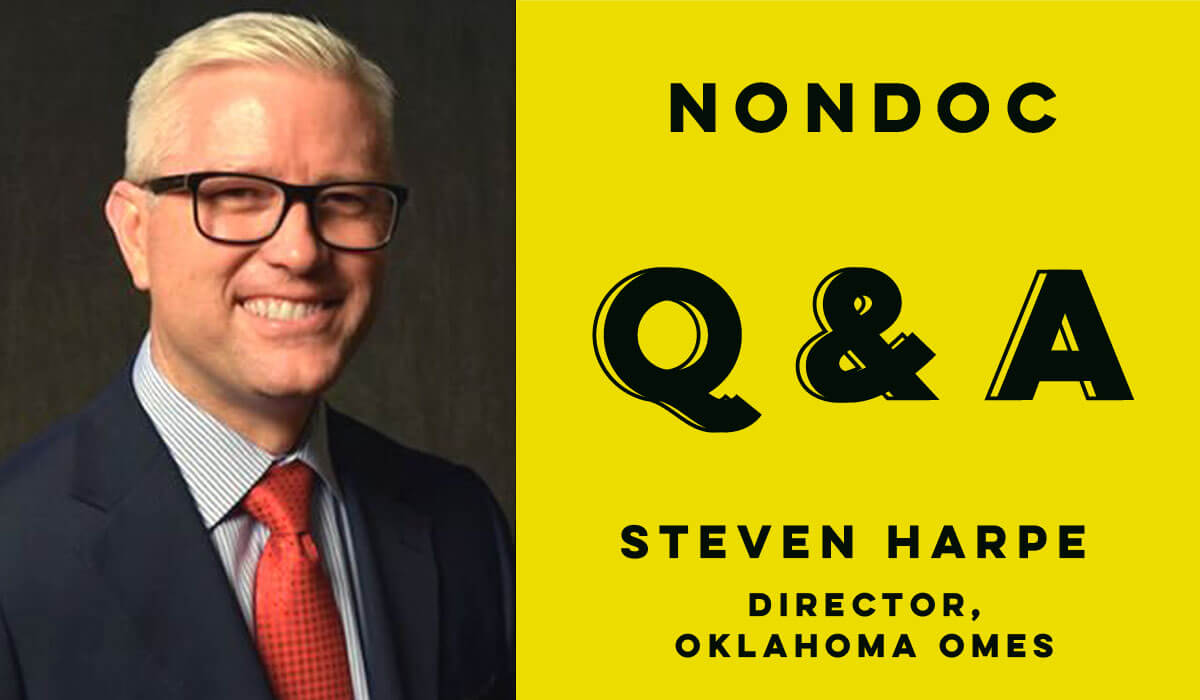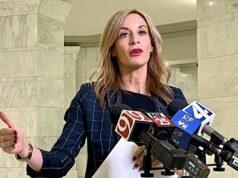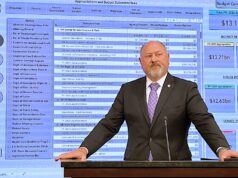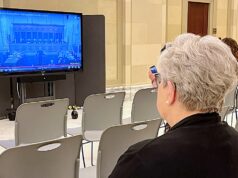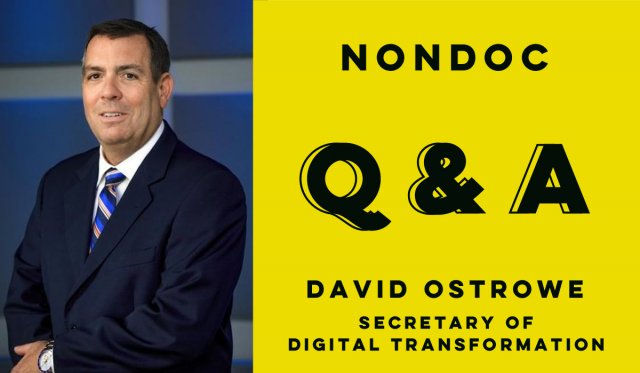

As Oklahoma’s first secretary of digital transformation and administration, David Ostrowe has been tasked with overseeing the digitization of state services — a pet initiative of Gov. Kevin Stitt.
He came into the job early last year while continuing his career as president of O&M Restaurant Group, which owns Burger King, Blaze Pizza and Taco Bell franchises in Oklahoma, Arkansas and Louisiana.
The COVID-19 outbreak has caused a sudden explosion in demand for online services in every sector, including the government. In particular, Oklahoma has joined other states in seeing a spike in unemployment claims far beyond what existing systems were prepared to handle.
On Friday, April 24, Ostrowe spoke with NonDoc about how the Oklahoma has coped with the surge in unemployment demands and about the wider trajectory of his efforts.
Tell us a little bit about yourself. How did you come into this job? Is there anything surprising about working in government that you’ve had to adjust to from the private sector?
I am actually a part-time employee. I started last year in January as secretary of digital transformation and administration. So, I have 50 agencies onboard the commission reporting to me, the largest being the Oklahoma Tax Commission. And I’m responsible for digital transformation for the entire state.
I find myself working with my fellow Cabinet members, the governor, the staff, the agency heads on state processes, to make sure that we’re all aligned, that we’re all communicating better, and our data free flows.
As far as adjustments from the private sector, I’ve always in the private sector taken problems on and found solutions to those problems. It always starts with people: Making sure you have the best people possible that can actually fulfill the mission that needs to be fulfilled.
If you surround yourself with good people, clear vision, funding and a good timeline, you can accomplish anything.
Overhauling the state unemployment system very quickly has been a recent focus of yours. And I know the unemployment website looks a lot better and that you’ve hired a lot of people. Are there other changes that have been happening that aren’t as visible.
I was involved with [Oklahoma Employment Security Commission Executive Director] Robin Roberson’s onboarding and interview. She is absolutely the perfect hire.
She was literally three or four weeks on the job when all hell broke loose. The [Oklahoma Employment Security Commission] is used to processing about 2,500 claims per week. Last week alone, they processed 45,000 new claims.
When the virus hit and we shut down the economy, we had a responsibility for people that need funds. So there’s been change overnight.
So through cooperation with [the Office of Management and Enterprise Services] and our new CIO, Jerry Moore, and our new director at OMES, Steve Harpe, we were able to go ahead and overhaul the front side — what the citizen sees.
Unfortunately, on the back side of that thing, we’re still dealing with old legacy systems, which Robin is working diligently to get overhauled.
RELATED
OMES director Steven Harpe: ‘Why are we still faxing?’ by Tres Savage
Every agency is now participating. A perfect example is the PUA, which is Pandemic Unemployment Assistance. The final guidance from the federal government came last Friday. Jerry Moore and his team at OMES went live on Sunday. So we’ve already collected 11,000 claims — 6,000 that are actually completed, 5,000 that are partially completed. We’re working through some tweaks with our mainframe. And we’re going to be one of the first states in the United States to issue payments.
So, again, this is state government being nimble. And it really starts a year ago, when digital transformation, along with OMES, started to build some processes to put state services like this online, under Jerry’s direction. So we had a tool in place, and we were able to go ahead and literally flip a switch to turn it on.
That’s what Gov. Stitt asked us to do day one. He wanted us to work together to solve problems and make a difference.
Let me take a crazy turn on you. Secretary (of Human Services) Justin Brown, with [the Oklahoma Department of Human Services], has started to help by giving us eligibility folks, eligibility systems that he uses at DHS, fraud investigators that he uses at DHS. So all of a sudden, this is the entire state government hyper-focused on fixing a problem that literally blew up because of the amount of volume that we’re seeing because of this crisis that we’re in.
Did that sudden burst in volume reveal flaws in the system that you weren’t aware of before, or did it just make things more urgent?
A little bit of both. Wednesday, there were 129,000 files that were in the system that had problems. These problems are when a citizen filled out the form, they checked yes when they should have checked no, or there was some other problem with the file that needed to be massaged. And the process was to have somebody call them.
We’re going to call 129,000 when we have 45,000 coming in now? I was like, that math doesn’t work. So we were able pull this data out, we were able to massage the data based upon things that we knew to be true. And we were able to use some AI tools. And between Wednesday night and last night — essentially a 24-hour period — I was able to get, the team was able to get, 71,000 of those addressed.
And, again, these are state workers that are working unbelievable hours through the weekend and late at night. And, I’m telling you, they’re doing it with a smile on their face. They know it’s their turn to help. So I can’t be more proud of them.
We were able to staff the call center so we could handle the volume. Through a partnership with Google, we were able to add in some chat boxes, using an artificial intelligence box to answer questions and keep people out of our key lines.
So these are things that we were able to do in a very short period of time. Two years ago, this stuff would have taken us years.
And what enabled you to move so quickly now?
A couple things. Some of the tools and systems we put in place early on. Having some of the right people in place to be able to go ahead and get this stuff done. Someone who comes to mind is Dustin Crossfield (the director of technology services at OMES), who was already in the thick of things. We’d solve one problem for one agency, and we’d immediately apply it to other agencies.
There’s not a lot of positive press out there about OMES. I’m telling you that they are a new organization under new leaders across the board. And a lot of the stuff we’re doing in-house instead of outsourcing.
Has the COVID-19 crisis has changed your priorities or perceptions about digital transformation as a whole?
You know, we were working toward the goal of every state service being available online in a mobile format. So as we look at social distancing and we look at the need to be able to telecommute and do these other things, it really kind of drives what we were already trying to achieve before this crisis.
Also, digital transformation owns broadband, and so we had already looked at a stress test on the network, both for government and our partners. So this leads to a lot of things we were already doing.
The Digital Transformation Fund became central to a big fight between the Legislature and the governor about state funding. And one critique that came out of that, from House Appropriations Chair Kevin Wallace, is that there hasn’t been sufficient information provided about how the fund will be used in the longterm. I’m wondering if there are more plans to provide a more detailed roadmap or what your thoughts are on that.
I’m not sure who made that statement and whether it’s accurate or not. I know that I personally — my last conversation with Chairman Thompson on the Senate side — was last night about 7 p.m. We speak frequently.
We report out as required by law. That report comes from the director of OMES, who oversees the fund. I get copied on it at the same time the pro tem and the speaker of the House. It goes out every month. I have one-on-one conversations with the appropriations chairs of both the House and Senate on a frequent basis.
I don’t want to get in between a budgetary battle. I kind of stay in my role and go after problems and try to solve problems. And with the COVID-19 crisis going on, my entire team was pivoted to assist agencies that need help.
The amount of work that we did with the Health Department, for instance — the Health Department picked up the tab on that. At the end of the day, rather than the Digital Transformation Fund, the agencies will have to pay for those activities in the future.
Last question, which I hope it’s not too personal. I know that you recently had COVID-19 and did a long quarantine yourself. How did that go and what did you do to pass the time?
I worked! The first week, we set up the system checker using Google technology. Google is going to talk about the strides that Oklahoma has made along with their partnership in their upcoming earnings release. We also set up the call centers during that period of time. So I accomplished a lot of work.
RELATED
Telemedicine shines as an option in age of coronavirus by Matt Patterson
I’m pretty productive. I haven’t worked out of my home in 15 years, so it was good to get back to that routine. Unfortunately, I gave COVID to my wife. My 22-year-old daughter I didn’t see for almost a month because she was petrified that we were going to give her the disease.
Week two of the virus, I was pretty miserable. I started having the respiratory problems. My wife never had the problems, so she took care of me.
You talk about digital transformation during this time, I did two telemedicine calls with Mercy. Had Mercy even offered that pre-COVID? It’s changing the world.
I can tell you that, as a business owner, it’s miserable, but I think we’re going to come out of this thing stronger. I think businesses are going to come out stronger, individuals are going to come out of it stronger. The state has already shown that they have amazing people, and everybody has been hyper-focused on getting this thing handled.









